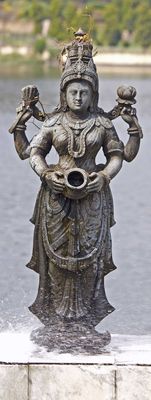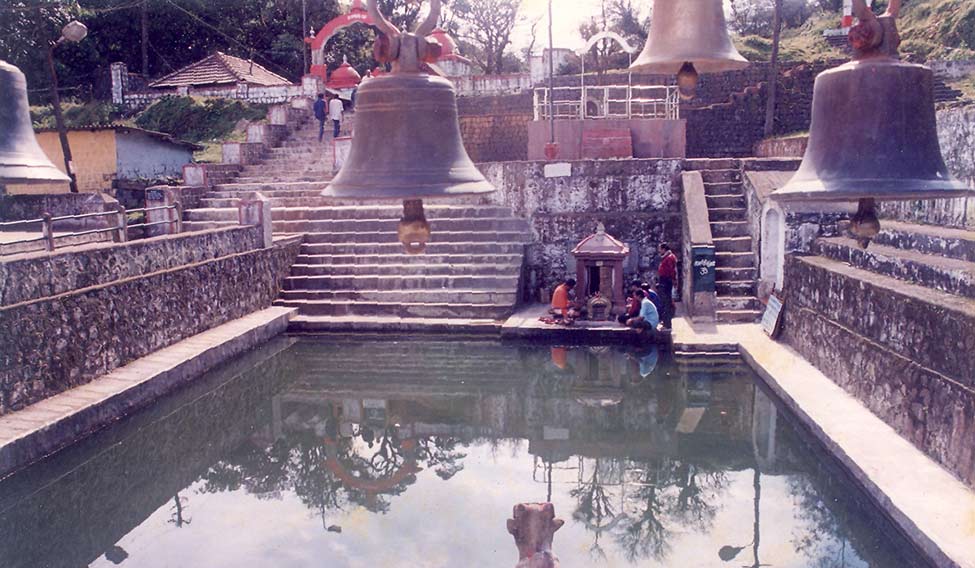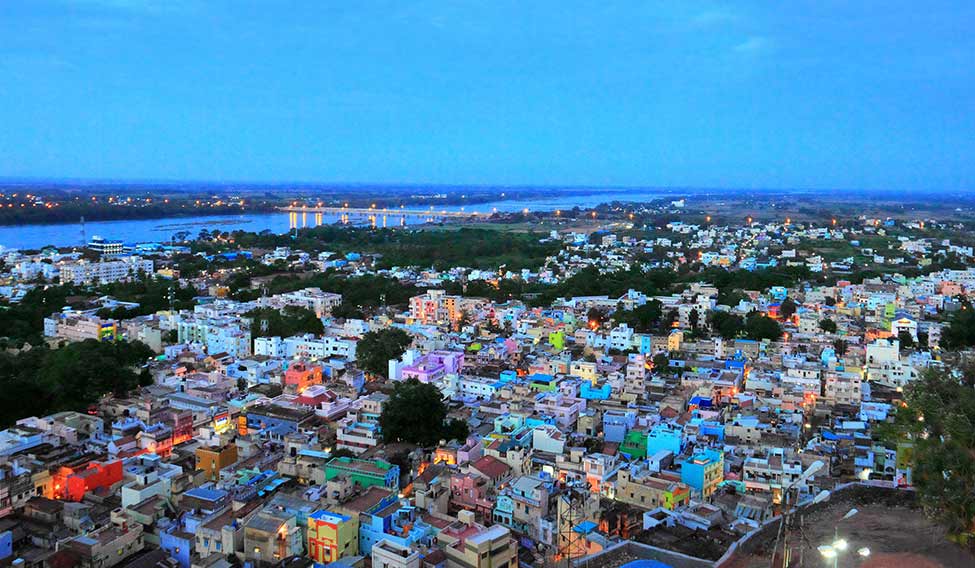Manimekalai, the first epic in Tamil literature, written about 1,800 years ago, opens with a beautiful legend. When the Chola king Kanthaman wanted to improve the water sources of his country, he prayed to sage Agasthya. Understanding the plight of the land, Agasthya tilted his water pot and the Cauvery streamed forth till she touched the ocean. The goddess Jambapathi, famed for her tapasya, immediately welcomed her: “Venavaa theertha vilakke vaa! [Quencher—light of this land’s water-thirst! Come!].”
Wherever the Cauvery has flowed, the river has been a mother to the people. In ancient times, the Chola kings were hailed as “the lords of paddy-growing waters” and the land was referred to as sorudaiththu, which gave food aplenty.
The Chola administrators gave much importance to the upkeep of water sources fed by the river. Apparently, floods in the Cauvery were a regular affair. The administrators had devised a Kaveri karai viniyogam (Cauvery banks tax) according to the inscriptions found in the Thiruppampuram temple renovated in the time of Kulothunga III (12th century Chola king). This was an occasional tax collected for strengthening the banks to protect the villages.
There seems to have been such an abundant flow in the Cauvery that to guard the land as well as increase the area under irrigation, rivers like Manni, Coleroon, Katuvai and Vanni were formed by bifurcating it. There is plentiful epigraphic evidence on these matters. Wherever there were vast landscapes, the ancient Tamils built huge tanks that were filled by the Cauvery. The Veeranam tank near Chidambaram, Cholavaridhi in North Arcot and Cholagangam to the west of Gangaikonda Cholapuram are justly famous.
 Sculpture of the Goddess Cauvery in the Brindaban Gardens at the Krishna Raja Sagara Hydro Power Station.
Sculpture of the Goddess Cauvery in the Brindaban Gardens at the Krishna Raja Sagara Hydro Power Station.
It is amazing how earlier generations guarded against wastage of water and sought ways to improve the use of available water for producing more food following the dictum of Taittiriya Upanishad: annam bahu kurveetha (grow lots of food)!
For Indians, a river is more than just the waters that flow in it. Cauvery is a goddess and this was demonstrated on an August-day when I stood watching the river from a vantage point at Srirangam. There was no water and yet the temple honours from Sri Ranganatha were brought to the river. Usually the gifts from the Lord are placed in the flowing river water with Vedic chants. Thousands converge on the banks bringing offerings and lighting lamps to set sail on the stream.
I was wondering what was going to happen. While the temple authorities dug a hole in the river bed till they got water and placed the garlands and other offerings in it, the common people brought pots of water from their homes for worship.
Cauvery obviously was not only a life-giving source but the very sustenance for the people’s soul. For such is the invaluable received tradition regarding Cauvery.
What confronts us immediately in the Cauvery delta civilisation are the massive temple structures raised by Cholas, Cheras, Pandyas and Pallavas in the course of 1,500 years. Interestingly enough, the prosperity gifted by the Cauvery turned the Tamil royalty towards raising immense temples to the gods, and not in building luxuriant palaces of dead perfection as the kings of France did in Louvre and Fontainebleau.
Building marvels in stone seems to have been in the genius of the people since Karikala Chola built the Grand Anicut (Kallanai) with stone across the Cauvery two millennia ago. Even today, the scenery in the area is breathtaking as we gingerly touch the huge stones showered by the Cauvery waters. Sublime names of the temples where people have been worshipping for more than a millennium sound like a Vedic chant: Tiruvidaimarudur, Mayiladuturai, Thiruvazundur, Nachiyar Kovil, Darasuram, Srirangam... the list grows long.
Stone structures alone do not make a living culture. The land irrigated by Cauvery was bountiful and so the settlements in this area grew large with people coming from all over India. Today a considerable section of the people have Marathi, Kannada or Telugu as their mother tongue. For instance, the grant of Thiruvisanallur by King Shahaji to 45 scholars in 1693 lists Telugu and Kannada families also. This diaspora brought their scriptures and arts and science with them to further enrich the Tamil culture.
An increasing number of devotees thronged the temples heeding the call given by the mellifluous hymnologists of Vaishnavism and Shaivism (3rd century to 9th century AD) who refer to the Cauvery river in ecstatic terms. Thondaradipodi Alwar of Srirangam sings of Cauvery that is holier than the Ganges, and how in the island created by the river’s flow lies sea-hued Ranganatha.
Thanks to nature’s bounty, there was an integral enjoyment of the physical, intellectual, psychic and spiritual aspects of life in this atmosphere. Indeed one of the terms used while worshipping Lord Sarangapani in Kumbakonam is, Cauvery theera rasikaaya namah (salutations to the enjoyer of the Cauvery environs).
Carnatic music in all its glorious rhythms and modes was fostered on the banks of Cauvery. The three great composers—Tyagaraja, Muthuswami Dikshitar and Syama Sastri—are the priceless gifts of Cauvery to Indian culture.
 Holy spring: Talacauvery, which is considered to be the source of the river Cauvery, at Brahmagiri hill in Kodagu, Karnataka | S. Pradeep
Holy spring: Talacauvery, which is considered to be the source of the river Cauvery, at Brahmagiri hill in Kodagu, Karnataka | S. Pradeep
There have been many spiritual luminaries, too, who have sanctified the Cauvery delta. It is as though there had been a concentration of the light divine on earth in this particular area during the 18th and 19th centuries. Sridhara Venkatesa Ayyaval and Bodhendra who initiated the Nama Siddhanta as a pathway for the common man to attain the divine belonged to these spaces.
In those days of ritual purity, Ayyaval fed a hungry Dalit with the food that had been specially cooked for offerings. Such humanism was resented by the priesthood. When the orthodoxy decided that a bath in the Cauvery was not enough to expiate the sin and that Ayyaval should go to Benares and have a purificatory bath there, it is said Mother Ganga simply streamed out of the well in Ayyaval’s house on the banks of Cauvery. Today the well is a place of pilgrimage.
The Andhra Brahmin Narayana Teertha, author of the lilting Sri Krishna Leela Tarangini, and Sadguruswamy who codified the Bhajana Paddhati that is followed by millions all over the world, literally transformed life in the delta into a life divine. With such a rich material and spiritual heritage, it is not surprising that this intellectual richness is thought of as the nectar of the gods bestowed by the Cauvery. The renowned novelist Kalki Krishnamurthy made the history and culture of Cauvery immortal in his epic novel Ponniyin Selvan (Son of Ponni). There is a unique flavour about the river, its environs, the culture it nurtured, immortalised by Shankar Ram in his The Children of the Kaveri. That flavour continues still, and may it continue, as expressed in Ilango Adigal’s poem in the Tamil epic Silapathikaram:
“With the dark bees buzzing as the crown,
Wearing a garment of flowerjewels,
The gleaming fish as your glances,
You streamed forth ; Long may you live, O Cauvery!”
The author is a well-known Tamil writer and scholar.
Originally published in THE WEEK in 2002





